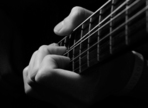
Basic Guitar Chords
Guitar essentials for writing songs and playing with other musicians

 Print
Print |
Basic Guitar Chords |
 |
| By FloSon on 09/21/2014 |  Print Print |
|
Learning chords just like that isn't very exciting, so I suggest you follow a chord progression that has a proven record for being rich and effective by many composers, as The Ukulele Orchestra Of Great Britain can attest.
Before moving on, you should know that guitar strings are usually tuned to E – B – G – D – A – E, from bottom to top, and they are numbered 1 to 6, also from bottom to top (thinnest to thickest).
Strictly speaking, there are no such things as "standard" chords. Contrary to the "academic" position with the wrist slightly arched ─ a position that will be mandatory for barre chords ─ the goal here is to play with the palm of your hand around the neck.
|
A minor
|
We start right away with a small detail: When you play this chord, you don't need to hear the lowest string. And you have two solutions to achieve that: You can simply avoid playing the string with your right hand (or left hand if you're a lefty) or you can mute it some way or another, as you'll see with the C Major chord.
|
D minor
|
You only have to play the bottom four strings. A very easy and easily rewarding chord.
|
G Major
|
Yet another easy-to-play chord that allows you to make the sound "fuller" by playing all the strings of the instrument.
|
C Major
|
In theory, the low E string shouldn't be played, but you can place your little finger on the third fret to strum all the strings and still get it right.
There are two easy tricks to mute the unwanted low E: You can press on it slightly with your thumb or use the index finger to touch the upper string to dampen it.
|
F Major
|
Since all strings need to be pressed and you most probably don't have six fingers, you'll need to be crafty. Fortunately there's the "thumb-over-the-top" technique, which allows you to play the low E while fretting the two bottom strings with the index finger, everything on the first fret.
|
Power B
|
If you are wondering what a power chord is, here's an example. Only strings 3, 4 and 5 are played, to give the chord more power, at the expense of harmonic richness. A very easy and indispensable fingering that you can move all along the neck.
|
E Major
|
To close the loop we have the lowest basic chord on a guitar (with a standard tuning), namely E Major, which uses all the strings.
Here's a brief example of how all these chords sound like one after the other with a folk guitar:
Even if they sound different, barre chords allow you to play the same chords that we just saw. Here's the evidence in pictures:
|
A minor barre chord
|
Let's start with the simplest voicing, an A minor, which ─ as all barre chords ─ can be played all along the neck to get any minor "standard" chord. Here I show you a technique to train your fingers and support the index with the middle finger.
|
D minor barre chord
|
Another classic chord that can be used under all circumstances and which can be transposed moving at will along the neck. The low E string shouldn't be played if it isn't damped.
|
G Major barre chord
|
It's almost the same as the A minor, but this time, the middle finger plays the 3rd string, and it all happens two frets up...or an E Major displaced three frets to shorten the neck with the help of the index finger, depending on where you look at it from.
|
C Major barre chord
|
Another way to do major chords. It allows you to change chords without the need to change frets with your hand. Like with the D minor, the low E should remain silent.
|
F Major barre chord
|
You will surely notice that it's the exact same chord as the one described above making use of the "thumb-over-the-top" technique, since the strings are fretted at the same frets. This chord can prove to be very painful when you start out. The only useful tip this time is to practice again and again...and again.
|
B minor barre chord
|
It uses the same position as the D minor barre chord, but you can add a subtle detail by lifting just slightly your index finger to let the high E string vibrate.
|
E7
|
Let's finish with a loosening exercise: An E7 chord that you can strum at leisure to get a nice bluesy touch.
Plus, here you have a brief example of how all these chords sound with an electric guitar:
Reproduction and distribution rights reserved © Audiofanzine 2024.
For personal use only. The user of the site acknowledges that he has read and accepts the general terms of use and that he will respect them.